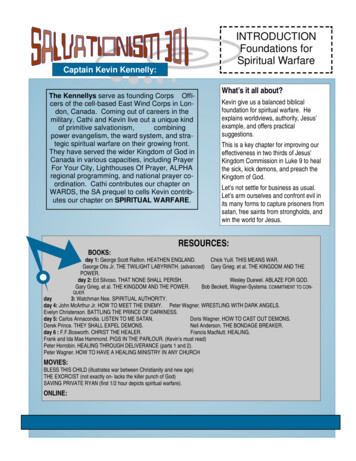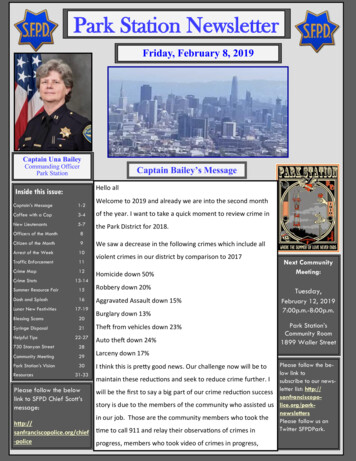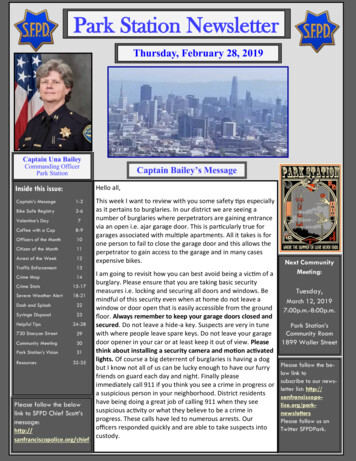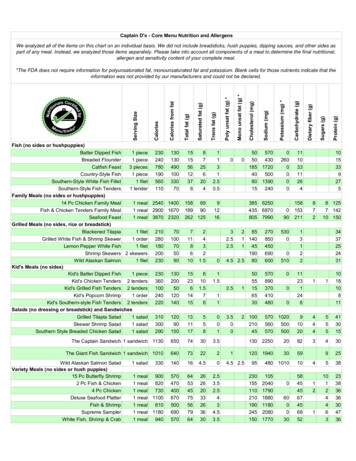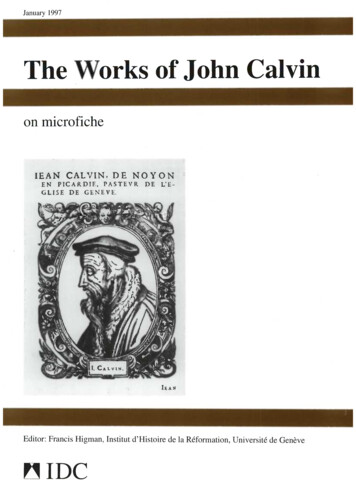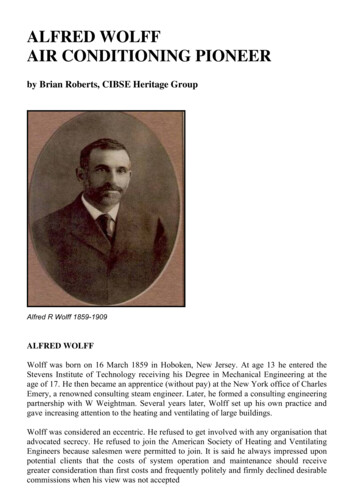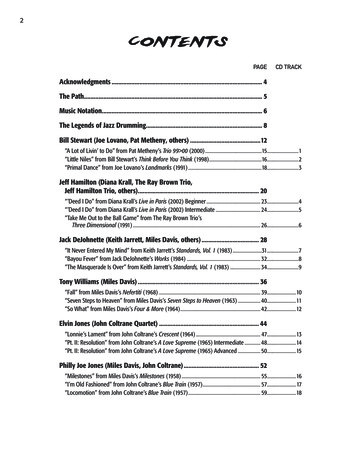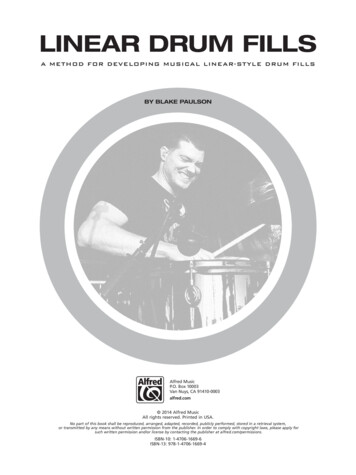
Transcription
SHOUT. Captain Alfred John, VC. MC (GVR)F Company, 1st Infantry Battalion.1st Infantry Brigade, 1st Division AIF“This was my first experience of individual courage-that stuff we call ‘guts’ and I’ve neverforgotten Shout.”Captain K. C. Millar, MC. ( Reveille. The official journal of the NSWRSL. 1 April 1936)V.C. CITATION.9th August 1915, at Lone Pine Trenches, Gallipoli Peninsula(Posthumous Award)For most conspicuous bravery at Lone Pine Trenches, in the Gallipoli Peninsula. On themorning of 9th August, 1915, with a small party, Captain Shout charged down trenches stronglyoccupied by the enemy and personally threw four bombs among them, killing eight and routingthe remainder. In the afternoon of the same day, from the position gained in the morning, hecaptured a further length of trench under similar conditions and continued personally to bomb theenemy at close range, under very heavy fire, until he was severely wounded, losing his right handand left eye. This most gallant officer has since succumbed to his injuries.(London Gazette: 15th October 1915.)M C. CITATION.On 27th April 1915, during operations near Gaba Tepe, for showing conspicuous courageand ability in organising and leading his men in thick, bushy country under very heavy fire. Hefrequently had to expose himself to locate the enemy and led a bayonet charge at a criticalmoment.London Gazette: 3 June 1915.Captain Alfred John Shout, VC, MC.Captain Alfred John Shout, who served with the Australian Imperial Forces on Gallipoli,was a New Zealander’ born on 7th August 1881. The eldest of the nine children born to JohnRichard Shout, a cook, (born 29 May 1856, in London) and his wife Agnes Mary (born 9 May1857, Dublin) the fourth daughter of Charles Kelly, a Royal Artilleryman and his wife Ann whosettled in Wanganui in 1859).Agnes and John had married in the St Mary’s of the Angels Church in Wellington threeand a half years after Agnes’s first husband, Bernard McGovern a soldier, had died. Bernard,twenty years older than Agnes, had married her when she was 16 years of age. Bernard andAgnes had one son, William (Bill) John McGovern who was born at Campbell Street Wanganuion 1 December 1875.Agnes and John Shout had five daughters and four sons; their first born was Alfred John,born at Bolton Street Wellington. His siblings were Agnes b 1883. Charles Thomas b 1885 whodied aged 12 years, Thomas Ben b 7.7.1887, Arthur James b 1889, twins Catherine Annie (Kitty)and Charlotte Ann (Lottie) b 1891, Winifred Mary (Jean) b 1897 and Marguerita Josephine (Jo) b1900.Alfred, Agnes, Charles and Tom were educated privately until the end of 1891 when theywere enrolled at the tiny bush school being constructed at Newman, 5kl north of Eketahuna,Masterton. They were foundation students of the school when classes commenced in 1892.1
His younger siblings Arthur and Catherine were attending Newman school at the timeAlfred left New Zealand for South Africa, with his half brother Bill McGovern, to enlist in theColonial Contingents that were fighting in the Anglo-Boer War.Alfred joined the Border Horse as a Trooper while Bill served as # 1835 TrooperW.J.Shout with Bethune’s Mounted Infantry and saw action in the Orange Free State and CapeColony. Bill returned to Wanganui when his term expired and reverting to his birth name ofMcGovern, married and settled into life as a farmer.The Border Horse served at Mafikeng under the command of Colonel Baden-Powell.Alfred Shout was wounded on two occasions, once in the chest. He was mentioned in despatches(Army Orders 23 February 1901) for his courage at Tabaksberg on 29 January 1901. He had kepthis men together and under heavy fire rescued a wounded man of the 17th Battery, RFA, carryinghim to a place of safety. He was made Queen’s Sergeant. His service medals for the campaignwere The Queen’s South Africa Medal and the King’s South Africa Medal.When his term expired, Alfred remained in South Africa serving as a Sergeant with theCape Field Artillery from 1903 till 1907. He married Rose Alice Howe, the daughter of Sydneycouple Arthur and Hannah Howe. Their only child, a daughter Florence Agnes Maud Shout, wasborn at Capetown, 11 June, 1905.Emigration to AustraliaAlfred Shout and his family moved to Australia in 1907 and he was employed as acarpenter and joiner at Resch’s Brewery, in Dowling Street Redfern. He lived with Rose andFlorence at 131 Darlington Road, Darlington and trained part-time with the 29th InfantryRegiment (Australian Rifles) while regularly competing in rifle club events. He wascommissioned as a Second Lieutenant with the 29th on 16 June 1914.Assigned to “F” Company of the 1st Battalion, 1st Division of the AIF on 18 August 1914three days after the Battalion had been formed at Randwick Racecourse, 33 year old Alfred JohnShout, was medically examined by Captain Wentworth Thompson who found him fit for overseasservice and recorded that he was 5’ 11” tall (180cm) and weighed 12 st (76kg).On 18 October the 1st Battalion with 2nd Lieutenant Alfred Shout and 23 year oldLieutenant Cecil Duncan Sasse in charge of ‘F’ Company marched through very heavy rain toWoolloomooloo to embark on A19, His Majesty’s Australian Transport Afric.Convoy to EgyptSailing without escort to Princess Royal Harbour Albany in Western Australia theyarrived on 25 October to find 15 other ships already waiting in the Harbour. A fire broke out on31 October onboard Afric, it was brought under control before they sailed the next day. Theywere part of a convoy of 36 transports taking 20,758 Australian troops, two New Zealandbrigades and 7,479 horses to England. The convoy’s Flagship, the 12,130 ton, A3 H.M.A.TOrvieto had Major General William Throsby Bridges and his staff of the 1st Division onboard. Italso carried 91 officers and 1,347 men of the 5th Infantry Battalion and 2nd Field Company.The escorts for the convoy were the Australian light cruisers H.M.A.S. Sydney andHMAS. Melbourne, and the Japanese battle cruiser Ibuki. They were led by the British cruiserHMS. Minotaur. On the first day out from Albany they were joined by two vessels fromFremantle and learned that England had declared war on Turkey.Four days later they passed the mail steamer Osterley, which reported that it had had anarrow escape from the German raider, the light cruiser SMS Emden. On 9 November themembers of the Contingent watched excitedly as H.M.A.S Sydney, commanded by Captain JohnC. T. Glossop, left the convoy at full steam to intercept the German cruiser as it attacked thewireless station on the Cocos Islands. The Sydney out-manoeuvred and out-gunned the Emden ina 90 minute battle, leaving her disabled and grounded on North Keeling Island.2
Their first port of call after crossing the equator was Colombo, docking at 8am on 13November. Alfred was granted leave on 15th and returned to the ship on the 19th November. Theconvoy sailed at 7.30pm that evening with escort duty now taken over by H.M.S. Hampshire.On 21 November the Afric bumped into another ship during rough weather causing thedeath of two soldiers who were lost overboard from the Afric. During this first three weeks of thevoyage 329 men were treated by the ship’s hospitals, 62 with measles and 55 Influenza, both veryinfectious diseases in the crowded conditions.On 24 November, HMS Hampshire left the convoy, which continued unescorted until itreached Aden at 5pm the next evening. Alfred, given leave overnight, arrived back at 6am torejoin the ship before it sailed up the Arabian Coast. Two days later orders were received that,due to the combination of the shortage of accommodation and training facilities in England andthe feared effects of the harsh English winter on the Anzac troops, they were to disembark inEgypt and establish training camps there.They called at Port Suez and Port Said before the men disembarked at Alexandria on 5December. Four days later they boarded a train for the 20 km journey to Mena, a small village inthe shadows of the Sphinx and three Pyramids, where they were to set up a training camp.GallipoliAlfred was appointed Lieutenant on 1 February 1915. On 25 April the 1st AustralianDivision, commanded by Major General Bridges, made an amphibious landing at Ari BurnuPoint (Anzac Cove) on the Gallipoli Peninsula. The 1st Brigade was led by thirty five year oldColonel Henry Norman MacLaurin, the son of the Chancellor of Sydney University.During his first two days on Gallipoli, Alf is reported to have carried at least 12 woundedback to the beach. He again showed conspicuous courage and ability at Walkers Ridge when,during a strong Turkish counter attack, he re-organised and led to safety the survivors of a sectionthat had suffered 50% casualties.He continually exposed himself to the enemy in order to establish their whereabouts then,although wounded he led a bayonet charge against them. When their newly acquired positionwas secured, Alfred and a corporal advanced into no-man’s land under heavy fire. They dug inand commenced sniping at the Turks. # 789 Pte Charles Huntley Thompson from Maitland NSWserving with the 13th Battalion said, “That was the bravest thing I ever saw”. For his action on 27April 1915 Lieutenant Alfred Shout was awarded the Military Cross.The troops had landed with rifle, bayonet and knapsack with 250 rounds of ammunition.By the 27th they were short of ammunition and water and exhausted through lack of sleep. Awithdrawal from the peninsular was discussed with General Sir Ian Hamilton before he made thedecision that the ANZAC Corps must hold their position and dig in.The 1st Division suffered 366 casualties during their first four days on Gallipoli. Alfredwas hit by a bullet that passed through his arm and entered his chest on the 27th. This was treatedon the Hospital Ship Gascon and Alfred returned to duty. He was wounded more seriously on 11May, again treated onboard the Gascon, he rejoined his unit on 26 May.On 29th July Alfred Shout was promoted to the rank of Captain and his dedication to dutyand bravery saw him receive a special mention in General Hamilton’s despatches, (LondonGazette: 5 August 1915, page 7668, position15).After months of trench fighting on Gallipoli a major offensive was planned for August.The New Zealanders would attack Chunuk Bair while the British staged a landing at Suvla Bay.Simultaneous attacks by the Australians would be made at The Nek by the untried 3rd Light HorseBrigade and at Dead Man’s Ridge, by the 1st Light Horse Regiment, while the 1st InfantryBrigade would charge the Lone Pine trenches.Lone Pine, a strong point of the Turks line, had briefly been in the hands of theAustralian’s on 25th April. On the night preceding their charge at Lone Pine Alfred Shout, in aneffort to relieve the anxiety among the members of his platoon, spoke to them at length about the3
coming event. He concluded his talk by telling # 721 Lance Corporal Alexander Ross McQueenfrom Gloucester, NSW “We will make a name for Australia and ourselves tomorrow Mac”.At midday on 6 August Captain Shout, MC instructed his men to discard their tunic andissuing them with pieces of white calico, told them to sew a strip on the arms of their grey flannelshirts and a square on the back. This would indicate their whereabouts to the artillery and theircomrades during the battle. While they were doing this the Battalion armourer sharpened theirbayonets.At 5.40pm the men of the 1st Brigade lined up ready to go over the top with unloadedrifles. The British Commander believed the sight of the Australian’s bayonets would be all thatwas needed to make the Turks flee before them. Following the exploding of three mines theAustralian’s had placed in tunnels dug under no-man’s-land the Turks were bombarded from bothland based artillery and naval ships.Those leading the charge reached the first trench quickly but found it difficult to attack asit was covered with pine logs. Some stayed to infiltrate the first trench, while others wereordered on to the second trench. Lone Pine was taken within the hour but the Turks, reformedand reinforced, counter-attacked and the battle for Lone Pine continued for three days. Casualtieswere high on both sides. During what was the only allied victory of the August offensive,Australians casualties were 80 officers and 2,197 other ranks while the Turkish 16th Division wasbelieved to have suffered almost 7,000 casualties.The 1st Battalion were relieved by the 7th Battalion and re-entering the line on the morningof 9 August, at a point known as Sasse’s Sap. This position was where Captain Cecil DuncanSasse, later Lieutenant Colonel DSO & Bar, had captured a section of the enemy’s trench threedays earlier.Discovering that the enemy had reoccupied a section of the trench he had previously heldSasse, with the assistance of three volunteers, re-entered the trench and killed the Turks who reoccupied it. Sasse then suggested Shout join him in a further assault on the Turks that afternoon.With the aid of some volunteers Sasse and Shout, following the previously successful planof attack, charged down the Turkish occupied trench. With Shout throwing bombs (Jam tinsfilled with explosives and jagged pieces of shrapnel) and Sasse making every shot from hisrevolver count, they killed eight of the Turks and captured a length of trench. Shout and Sassethen held the attacking Turks at bay while the volunteers built a sand bag barricade to secure thecaptured section.The process was successfully repeated a second time before they set off down the trench athird time for what they planned would be their final dash for the day. Shout revelling in thefight, lit the fuses of his three remaining bombs. Throwing two, he was in the process ofthrowing the third when it exploded prematurely blowing off his right hand and severelywounded the right side of his face and body.Although mortally wounded, Shout continued to direct the men building the barricadethen, murmuring “Good old First Brigade, well done!,” he lost consciousness. Carried to the rearhe regained consciousness and had a cup of tea as he awaited the stretcher bearers who took himto the beach. Captain Alfred Shout MC died from his wounds onboard the hospital ship Neuralia11 August, 1915 and was buried at sea.Seven Australian soldiers were awarded the Victoria Cross for their actions at Lone Pine.Captain Shout’s award, a posthumous award, appeared in the London Gazette 15 October 1915.The others were; English born Lance Corporal Leonard Keysor of the 1st Battalion, Private JohnHamilton a butcher from Penshurst, NSW of the 3rd Battalion, and four Victorians from the 7thBattalion; Captain Frederick Tubb, Lieutenant William Symonds and Corporals AlexanderBurton and William Dunstan.Alfred Shout’s service medals were the QSAM., with bars for Wittebergen, Transvaal andCape Colony, the KSAM., with bars for South Africa 1902 and South Africa 1901, 1914-15 Star,British War Medal and Victory Medal with Bronze Oakleaf.4
Home in Australia.Rose Shout, living at 20 Forbes Street Darlington was notified by cable on each occasionAlfred was wounded. She replied seeking news of her husband’s wellbeing and his whereabouts.Army Records relating to Shout’s death were altered on receipt of a cable fromAlexandria on 20 August which read “Not dead! Onboard ‘Themistocles’, returning toAustralia.”. The Australian press advised it’s readers that Captain Shout would arrive in Sydneymid-September. At a later inquiry the official explanation for this mistake was that 2ndLieutenant Arthur John Shirt, returning to Australia on ‘Themistocles’, had been mistaken forLieutenant A. J. Shout.English born 2nd Lieutenant Shirt enlisted 24 August 1914 and was promoted to Sergeanton 18 October 1914. On the 2 May 1915 he was promoted to 2nd Lieutenant while serving withthe 1st Battalion. On 11 June he became ill with Influenza on Gallipoli and was transferred to HSGrantully Castle for treatment. 6th July he reported sick with Rheumatism and was transferred toHospital in Heliopolis. On the 15 August 1915 he embarked on “Themistocles” in Cairo to bereturned to Australia. Discharged unfit for further service Shirt re-enlisted in 1917 and served inthe 55th Battalion. He was again hospitalised with Influenza at Harefield, England in August1918 and returned to Australia where he was discharged 12 November 1918.Rose Shout was officially informed of her husband’s death. However his father, living inNew Zealand, had to write to the Army on 4 September seeking conformation of his son’s deathafter reading a newspaper report.Rose was awarded a pension of ninety one pound ( 182) per year and Florence thirteenpound ( 26) per year, as the widow and child of Lieutenant A. J. Shout. On 28 October 1915,Rose drew the Army’s attention to the fact that her husband had been promoted to the rank ofCaptain on the day he was mortally wounded and had been awarded a posthumous VictoriaCross.While conceding that Shout had been promoted to Captain just days before he wasmortally wounded, on 19 November 1915, the Officer in Charge of Base records deniedknowledge of Captain Alfred Shout being awarded a Victoria Cross. This was despite the awardbeing gazetted more than a month earlier. Confirmation of his rank and award resulted in Rose’spension increasing ten pound ( 20) per year while Florence’s pension doubled.Rose received Alfred’s identity disc on 4 February 1919. The Certificate acknowledginghis being Mentioned in Despatches was received by Rose on 24 July 1921 with Alfred’sMemorial Scroll containing the King’s Message.The citizens of Darlington commemorated the name of Captain Alfred Shout VC, MC. ona memorial plaque unveiled on 20 November 1915 by Australia’s Scottish born GovernorGeneral Sir Ronald Craufurd Ferguson PC GCMC. The plaque is now housed in the VictoriaBarracks Museum along with other memorabilia donated in 1980 by Florence Thomas, thedaughter of Alfred and Rose.The RSL, with the assistance of the New South Wales Government, launched a successfulappeal in August 1916 to buy a home for Rose and Florence Shout.In 2001 the Redfern R.S.L. Sub-Branch in Sydney placed a framed montage, whichincluded Replica Medals and photographs of Captain Alfred Shout VC., MC. at Gallipoli, in thefoyer of their Club.The name of Captain Alfred Shout VC, MC, 1st Battalion, A. I. F. is inscribed on Panel 12of the low wall in front of the Lone Pine Memorial. The names of the Australian’s who died atGallipoli who lay in unknown graves or were buried at sea are inscribed on this wall.Shout’s name is on Memorial panel 30 at the Australian War Memorial, Canberra; TheAustralian Victoria Cross Memorial in Campbell, Canberra and the Darlington Memorial Gatewhich stood at the entrance of the Darlington School. This memorial still stands in its originalposition within the grounds of the University of Sydney.5
He is remembered on the NewZealand Victoria Cross Memorial inQueens Gardens, Dunedin, Otago and onthe Honor Roll at Newman School.Rose Shout married AlfredGeorge Lovel in 1928. Alfred died 1964and Rose 4 November 1975 at Earlwoodin Sydney.The Redfern RSL sub-branch isseeking Government assistance to erecta Memorial in Redfern to two VictoriaCross Recipients who had connectionswith the district. Captain Alfred ShoutVC. MC. and Warrant Officer RayeneSimpson VC. DCM.The 18th Battalion Rifle Clubholds an annual 303 shoot at Kariong,New South Wales for the Captain Alfred Shout VC., MC. Trophy.Alfred Shout’s brother, Corporal Arthur James Shout had served with the Australian 38thBattalion, wounded at Passchendaele he was returned to Australia, for his years of dedication asClub Secretary he was granted life membership of the Frankston Returned Servicemen’s Club(Victoria).A frame housing the Medals of Captain Shout VC., MC., minus his Mentioned inDispatches bronze oakleaf, and containingother memorability; a cap badge, anofficer’s pip, a photograph of Shout, twonon-military awards presented to RoseShout and a typed copy o
The New Zealanders would attack Chunuk Bair while the British staged a landing at Suvla Bay. Simultaneous attacks by the Australians would be made at The Nek by the untried 3rd Light Horse Brigade and at Dead Man’s Ridge, by the 1 st Light Horse Regiment, while the

